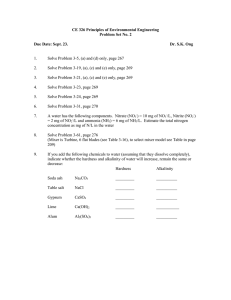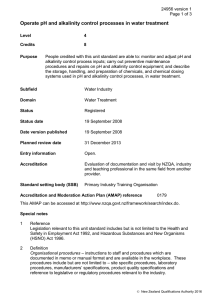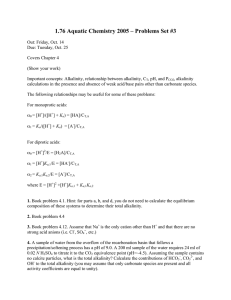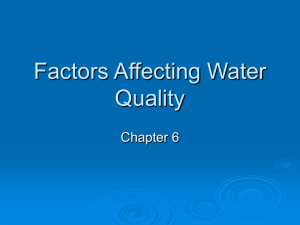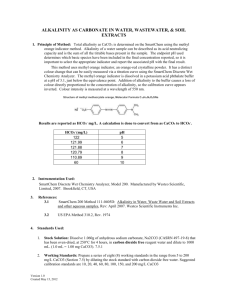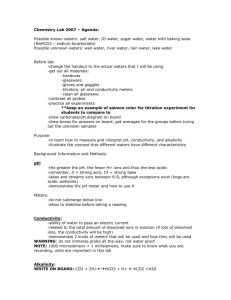Demonstrate knowledge of hardness, pH, and alkalinity control
advertisement
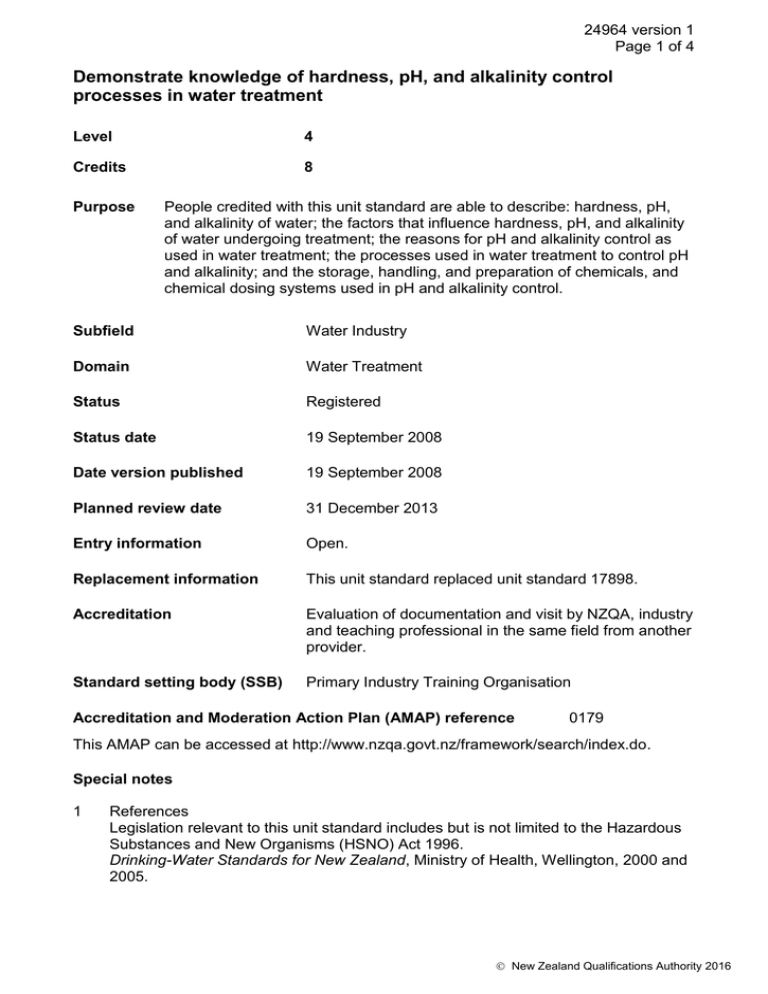
24964 version 1 Page 1 of 4 Demonstrate knowledge of hardness, pH, and alkalinity control processes in water treatment Level 4 Credits 8 Purpose People credited with this unit standard are able to describe: hardness, pH, and alkalinity of water; the factors that influence hardness, pH, and alkalinity of water undergoing treatment; the reasons for pH and alkalinity control as used in water treatment; the processes used in water treatment to control pH and alkalinity; and the storage, handling, and preparation of chemicals, and chemical dosing systems used in pH and alkalinity control. Subfield Water Industry Domain Water Treatment Status Registered Status date 19 September 2008 Date version published 19 September 2008 Planned review date 31 December 2013 Entry information Open. Replacement information This unit standard replaced unit standard 17898. Accreditation Evaluation of documentation and visit by NZQA, industry and teaching professional in the same field from another provider. Standard setting body (SSB) Primary Industry Training Organisation Accreditation and Moderation Action Plan (AMAP) reference 0179 This AMAP can be accessed at http://www.nzqa.govt.nz/framework/search/index.do. Special notes 1 References Legislation relevant to this unit standard includes but is not limited to the Hazardous Substances and New Organisms (HSNO) Act 1996. Drinking-Water Standards for New Zealand, Ministry of Health, Wellington, 2000 and 2005. New Zealand Qualifications Authority 2016 24964 version 1 Page 2 of 4 Standard Methods for the Examination of Water and Wastewater, prepared jointly by American Public Health Association (APHA), American Water Works Assocation (AWWA), Water Environmental Federation (WEF) (Washington: American Public Health Association, 1998). ISBN 0-87553-235-7. 2 A person is required to have approved handler certification if handling substances being transferred under the HSNO Act 1996. Information on approved handler procedures can be obtained from http://www.erma.govt.nz. Elements and performance criteria Element 1 Describe hardness, pH, and alkalinity of water. Performance criteria 1.1 Hardness, pH, and alkalinity are described in terms of their differences. 1.2 Hardness, pH, and alkalinity of water are described in terms of their interrelationships. 1.3 The characteristics of water are described in terms of hardness, pH, and alkalinity. Element 2 Describe the factors that influence hardness, pH, and alkalinity of water undergoing treatment. Performance criteria 2.1 Chemicals present in untreated water are described in terms of their impact on water hardness, pH, and alkalinity. Range 2.2 includes but is not limited to – carbon dioxide, carbonate, bicarbonate, sulphates, chlorides, natural organic matter. Standard water treatment chemicals are described in terms of their effect on pH and alkalinity. Range includes but is not limited to – alum, hydrated lime, soda ash, caustic soda, carbon dioxide, sulphuric acid. Element 3 Describe the reasons for pH and alkalinity control as used in water treatment. Performance criteria 3.1 pH and alkalinity are described in terms of their effect on treatment processes and control, and the reasons for their variations. New Zealand Qualifications Authority 2016 24964 version 1 Page 3 of 4 3.2 The pH range of drinking water is identified and described in accordance with the Drinking-Water Standards for New Zealand. 3.3 pH value and disinfection efficiency are described in terms of the relative impact of pH on chlorination, ozonation, and ultra-violet methods. 3.4 pH and alkalinity in the water distribution system are described in terms of the measurement of their effects. Range effects include but are not limited to – elevated heavy metal content, asbestos cement deterioration, scale formation, concrete lining deterioration, staining and dirty water, tuberculation, pitting, corrosion; measurement methods include but are not limited to – Langelier Stability Index (LSI), plumbosolvency. Element 4 Describe the processes used in water treatment to control pH and alkalinity. Performance criteria 4.1 Chemicals, pH and alkalinity, and related components are described in terms of adjustment techniques. Range 4.2 includes but is not limited to – aeration, alkali addition, acid addition, CO² addition; components include but are not limited to – dry powder feeders, mixing tanks, dosing pumps, carry water, solution strength. pH control methods used in water treatment are described in terms of chemical dosing. Range control methods – pH measurement, calibration, feedback control loops. 4.3 pH, hardness, and alkalinity are determined using laboratory techniques in accordance with Standard Methods for the Examination of Water and Wastewater. 4.4 The components involved with pH and alkalinity control are described in terms of their limitations. Range components include but are not limited to – dry powder feeders, mixing tanks, dosing pumps; limitations include but are not limited to – safety, line cleaning, flushing. New Zealand Qualifications Authority 2016 24964 version 1 Page 4 of 4 Element 5 Describe the storage, handling, and preparation of chemicals, and chemical dosing systems used in pH and alkalinity control. Performance criteria 5.1 The storage, handling, and preparation of chemicals used in pH and alkalinity control are described in terms of the Health and Safety in Employment Act 1992, and HSNO Act 1996 and regulations. 5.2 Chemical dosing systems used in pH and alkalinity control processes are described in terms of the components, methods, and points of application. Range components – chemical pipework, dosing pumps, speed control, stroke control, flow rate, tank of dilutant, instrumentation for automatic control. Please note Providers must be accredited by NZQA, or an inter-institutional body with delegated authority for quality assurance, before they can report credits from assessment against unit standards or deliver courses of study leading to that assessment. Industry Training Organisations must be accredited by NZQA before they can register credits from assessment against unit standards. Accredited providers and Industry Training Organisations assessing against unit standards must engage with the moderation system that applies to those standards. Accreditation requirements and an outline of the moderation system that applies to this standard are outlined in the Accreditation and Moderation Action Plan (AMAP). The AMAP also includes useful information about special requirements for organisations wishing to develop education and training programmes, such as minimum qualifications for tutors and assessors, and special resource requirements. Comments on this unit standard Please contact the Primary Industry Training Organisation standards@primaryito.ac.nz if you wish to suggest changes to the content of this unit standard. New Zealand Qualifications Authority 2016

